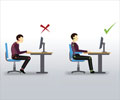A new study has found interesting physical and psychosocial factors that could significantly increase the risk of the onset of low back pain.

“Understanding which risk factors contribute to back pain and controlling exposure to these risks is an important first step in prevention,” explains Associate Professor Manuela Ferreira, Ph.D., with The George Institute for Global Health and Sydney Medical School at The University of Sydney in New South Wales, Australia. “Our study is the first to examine brief exposure to a range of modifiable triggers for an acute episode of low back pain.”
For this case-crossover study, researchers recruited 999 participants from 300 primary care clinics in Sydney, Australia, who had an acute low back pain episode between October 2011 and November 2012. Study subjects were asked to report exposure to 12 physical or psychosocial factors in the 96 hours prior to the onset of back pain.
The risk of a new episode of low back pain significantly increased due to a range of triggers, from an odds ratio of 2.7 for moderate to vigorous physical activity to 25.0 for distraction during an activity. Researchers found that age moderated the effect of exposure to heavy loads, with odds ratio for individuals 20, 40, or 60 years of age at 13.6, 6.0, and 2.7, respectively. A new finding not reported previously was that back pain risk was highest between 7:00 a.m. and noon.
“Understanding which modifiable risk factors lead to low back pain is an important step toward controlling a condition that affects so many worldwide,” concludes A/Prof Ferreira. “Our findings enhance knowledge of low back pain triggers and will assist the development of new prevention programs that can reduce suffering from this potentially disabling condition."
Advertisement
Source-Medindia















